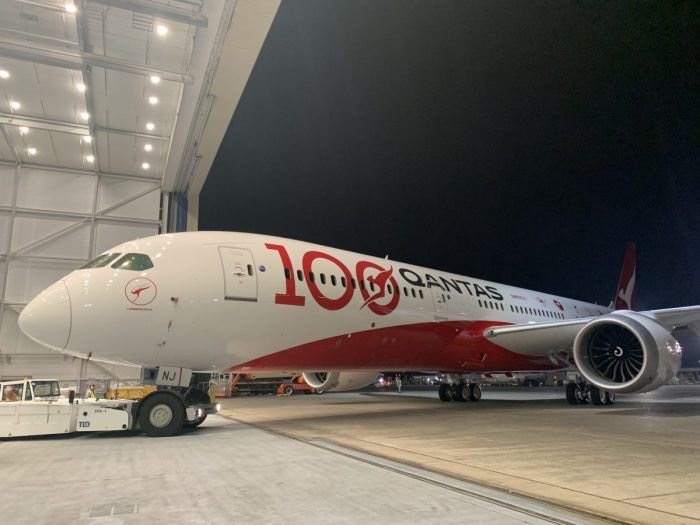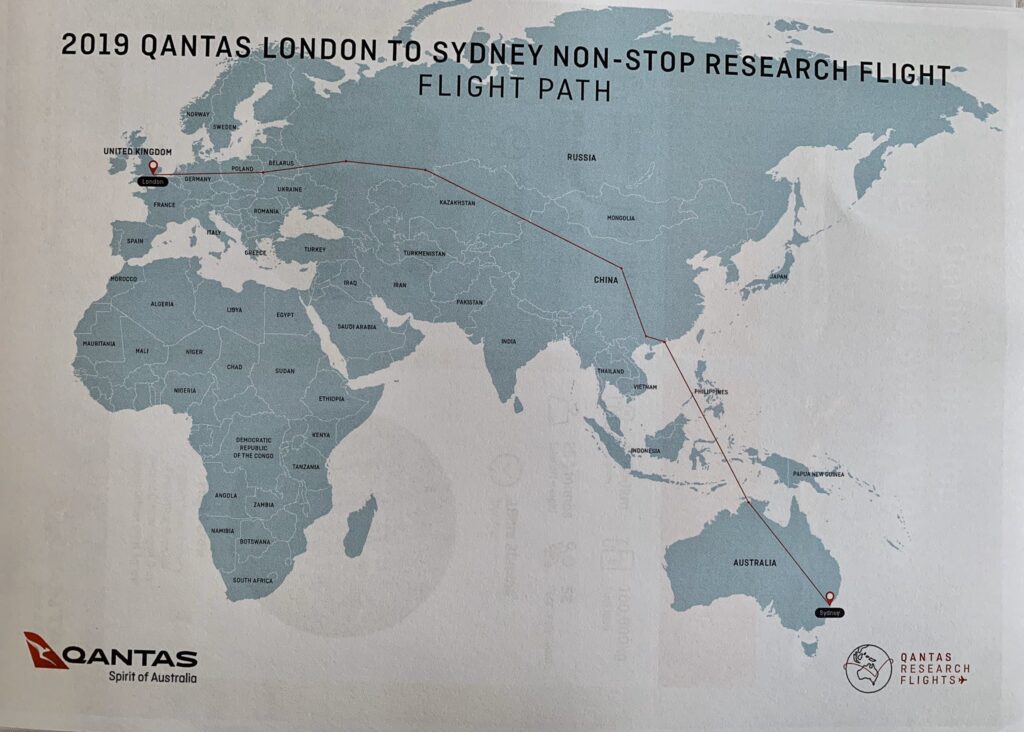Qantas Sydney London non stop test flight
A Qantas London Sydney test flight will take place this week, part of an ambitious project to test the limits of commercial flight around the world.

VH-ZNJ, a Qantas 787 Dreamliner, has been tasked with the monumental non stop Australian east coast to London service.
The Qantas QF7879 Flight, non-stop London to Sydney will travel over 11 countries: England, Netherlands, Germany, Poland, Belarus, Russia, Kazakhstan, China, Philippines, Indonesia & Australia.
The epic flight will take 19hrs 30mins. Thats a total of 17,800kms flying without stopping to refuel, across Europe, Asia, the Pacific Ocean until finally arriving in Australia.
Here is the Qantas London Sydney direct flights path:

Qantas non-stop research flight London to Sydney routing
The aircraft, registered VH-ZNJ and named Longreach, features a special Qantas Centenary livery with all the Qantas logos painted on the side, as featured in this article:
Flight Fast Facts
- QF 7879 flight from London to Sydney will take around 19-and-a-half hours, subject to wind and weather conditions on the day. Distance between London and Sydney is 17,800 kilometres (11,000 miles). This compares to a travel time of 22 hours and 35 minutes on the current London to Sydney via Singapore flight.
- The flight will be operated by a brand-new Boeing 787-9 with a special Qantas Centenary livery, registration VH ZNJ, named “Longreach”.
- Four pilots will be on rotation throughout the flight. Two additional pilots will be in the cabin, having flown the aircraft to London.
- The route will depart London and overfly 11 countries including England, Netherlands, Germany, Poland, Belarus, Russia, Kazakhstan, China, Philippines and Indonesia, before crossing the Australian coast near Darwin then tracking across the country before finally descending into Sydney.
- The aircraft will operate with a maximum fuel load of approx. 126,000 litres. Projected fuel remaining upon landing is approximately 7,500 litres, which translates to about 100 minutes of flight time.
- Maximum take-off weight for a 787-9 is 254,000kg. QF 7879 LHR to SYD will depart at a 233,000kg take-off weight; the same amount of fuel that Qantas departs Perth to London flights with.
- Flight will travel at 85% the speed of sound which is around 930 kilometres an hour. Cruising altitude will start at 35,000 feet and then, as the aircraft weight reduces with fuel burn, the cruising altitude will be increased to 40,000 feet.
On board will be 50 passengers/crew including Sam Chui who will be covering various stages of this prestigious event. Six Qantas Frequent Flyers will be taking place in passenger research covering fatigue, bodily functions and comfort.
Additionally, the pilots will be wearing devices monitoring brain performance, sleep cycles, wellness and other critical functions.
Passengers and crew are monitored seven days prior to the flight and will be continually monitored for another 14 days after landing.
The data collected by the University of Sydney’s Charles Perkins Center, as well as the Cooperative Research Center (CRC), will be used to determine Alertness, Safety and Productivity.
CRC have advised the following strategies to combat jetlag. Set the body clock to Sydney immediately after takeoff and sleep first.
One such flight left for New York to Sydney a few weeks ago.
Each flight will have a maximum of 40 people, including crew, in order to minimise weight and give the necessary fuel range. Carbon emissions from the flights will be fully offset.
The on-board research is being designed in partnership with Sydney University’s Charles Perkins Centre and Monash University in conjunction with CRC for Alertness, Safety and Productivity.
People in the cabin – mostly Qantas employees – will be fitted with wearable technology devices and take part in specific experiences at varying stages of the approximately 19 hour flights. Scientists and medical experts from the Charles Perkins Centre will monitor sleep patterns, food and beverage consumption, lighting, physical movement and inflight entertainment to assess impact on health, wellbeing and body clock.
Monash University researchers will work with pilots to record crew melatonin levels before, during and after the flights. Pilots will wear an EEG (electroencephalogram) device that tracks brain wave patterns and monitors alertness. The aim is to establish data to assist in building the optimum work and rest pattern for pilots operating long haul services.
Qantas Group CEO Alan Joyce said the flights will give medical experts the chance to do real-time research that will translate into health and wellbeing benefits.
“Ultra-long haul flying presents a lot of common sense questions about the comfort and wellbeing of passengers and crew. These flights are going to provide invaluable data to help answer them.
“For customers, the key will be minimising jet lag and creating an environment where they are looking forward to a restful, enjoyable flight. For crew, it’s about using scientific research to determine the best opportunities to promote alertness when they are on duty and maximise rest during their down time on these flights.
“Flying non-stop from the East Coast of Australia to London and New York is truly the final frontier in aviation, so we’re determined to do all the groundwork to get this right.
Related: How to get Qantas lounge access
Historic Qantas flight New York Sydney non stop

